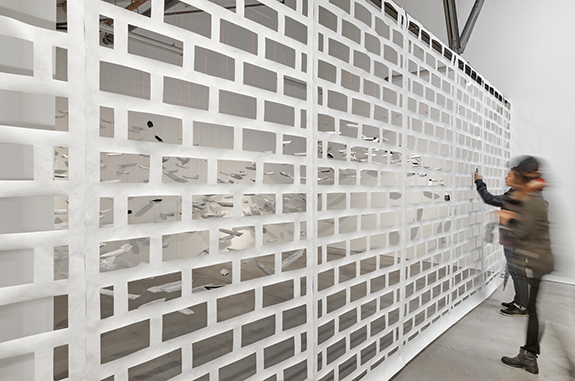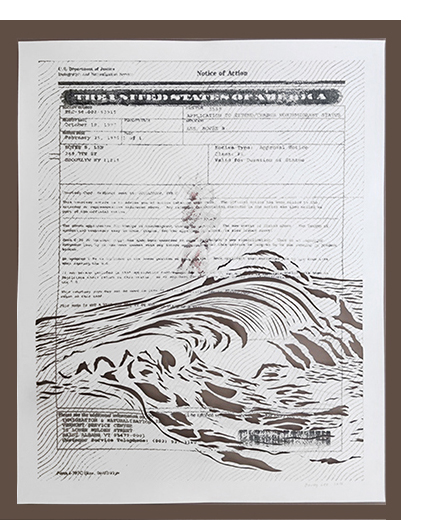 |
by Maria Porges
For the past year, the image of a wall has loomed large, both as a metaphor for old-style American isolationism and as a physical thing: an impossibly long barrier intended to prevent immigrants from entering the US. In The Sea Will Come to Kiss Me, Los Angeles-based artist Bovey Lee addresses both the metaphor and the reality of a border wall. She has built one of her own, 12 feet high and 25 feet long, out of a single, continuous sheet of white Tyvek, a synthetic wrap used to protect buildings during construction. From it, she excised rectangular shapes, which are framed by latticed white spaces that stand in for mortar. Through these tiny windows, a swelling wave of dozens of folded paper boats can be seen, each suspended on a length of red thread that is yoked to one of a series of parallel cords crossing the width of the room at the same height as the wall. The boats, fashioned from photocopies of the artist’s immigration documents, tremble slightly as visitors come and go, turning just a little in the moving air.
Though her application for U.S. citizenship succeeded, Lee kept a decade’s worth of the papers. Unable to part with this proof of her citizenship, Lee has retained these stacks of papers as one keeps photographs, for a sense of self, for proof of the past, and as an anchor indicating safe harbor. Last year, as anti-immigrant, anti-woman, white supremacist rhetoric ramped up throughout the presidential campaign,
.jpg) |
she began to think about creating a piece that reflected her inner turmoil.
Since 2005, Lee’s work has consisted primarily of almost inconceivably intricate compositions of presence and absence: fanciful pictures cut out of Chinese xuan (rice) paper and floated in front of a backing of silk in shadowbox frames. Periodically, however, she has diverged from this extended body of work to create installations, shifting to a different material as necessary to work on a larger scale, as she does here. This piece, however, represents a new method, in that the boats’ open, canoe-like forms are folded rather than cut.
She has not, however, abandoned cut paper. Eight such pieces appear nearby; to create them, Lee took enlarged photographic reproductions of her petitions to the Department of Justice and incised them with images of waves. In addition, the small rice cooker she brought when she
came to the US for the first time (at her mother’s insistence) and a small US flag, given to all new citizens, sit together on a shelf — as if bookending her journey of becoming an American. These additions seem secondary, though, overshadowed by the wall and the hanging vessels. Oddly, the latter suggest a flock of birds, captive in a cage; the Tyvek lattice makes a fourth wall
 |
for the u-shaped room in which the piece is installed, evoking a prison cell. The boats are also an ironic embodiment of the aphorism “a rising tide lifts all boats” (an expression used to defend tax cuts and other emoluments for the rich), even as they suggest the desperation of those who leave their native country seeking a new life, crossing oceans in rafts and rowboats, or– as many European-Americans did– in little wooden ships.
Does a wall keep immigrants out or keep citizens fenced in? In the alt-right’s version of reality — in which Manifest Destiny is still in vogue, and the so-called pioneers who stole the country from its original occupants are the only REAL Americans — it is hard to tell which function is more important. The sea will come to kiss me may not be as exquisite as the artist’s cut paper pieces, but by reminding us of a political reality we can’t forget even for a minute, it has instructive value and terrible beauty.
Though the artist doesn’t acknowledge it, the installation’s poetic title comes from a Trent Reznor song for Nine Inch Nails. The verse in its entirety seems appropriate to the spirit of Lee’s work—and to the determination with which waves of immigrants keep on coming, making America great because of its diversity, not in spite of it:
And when the day arrives I'll become the sky
and I'll become the sea and the sea will come to kiss me
for I am going home. Nothing can stop me now.
# # #
Bovey Lee: “The Sea Will Come to Kiss Me,” @ Rena Bransten through February 25, 2017.
About the Author:
Maria Porges is an artist and writer who lives and works in Oakland. For over two decades, her critical writing has appeared in many publications, including Artforum, Art in America, Sculpture, American Craft, Glass, the New York Times Book Review and many other publications. The author of nearly 100 exhibition catalog essays, she presently serves as an associate professor at California College of the Arts.